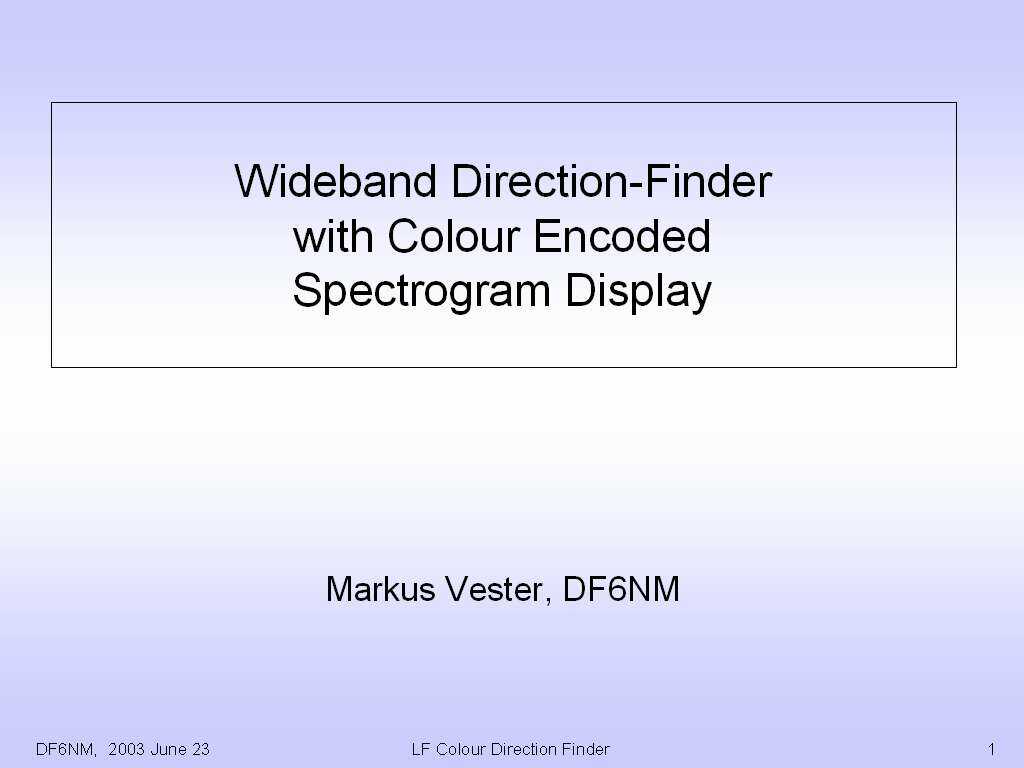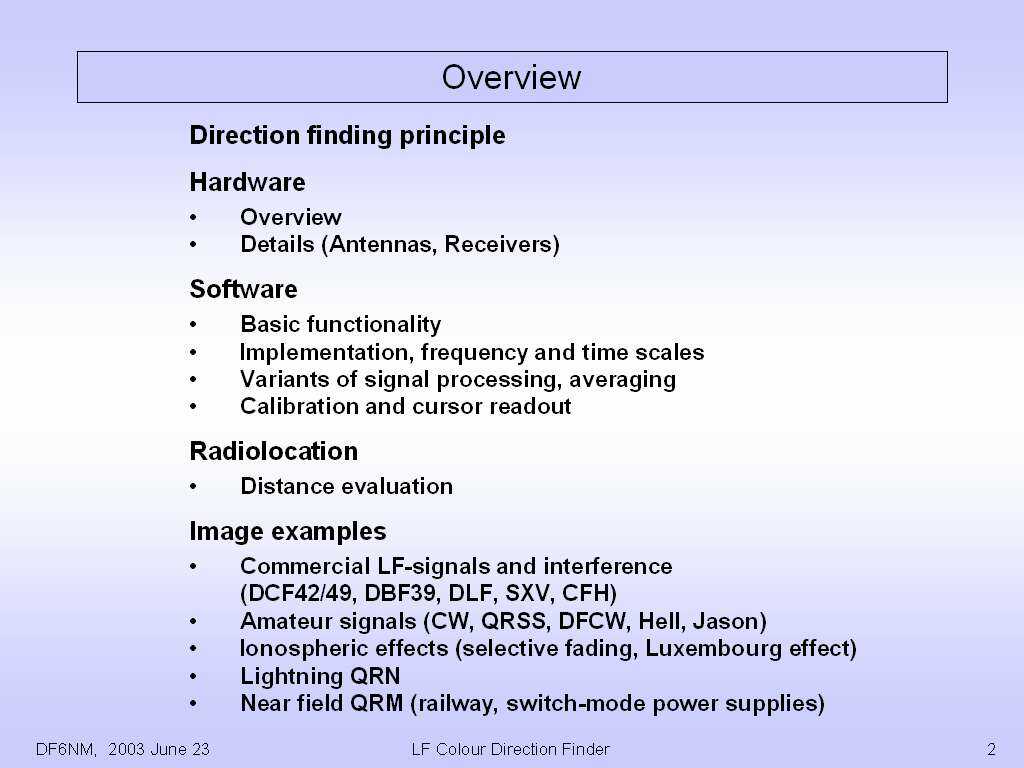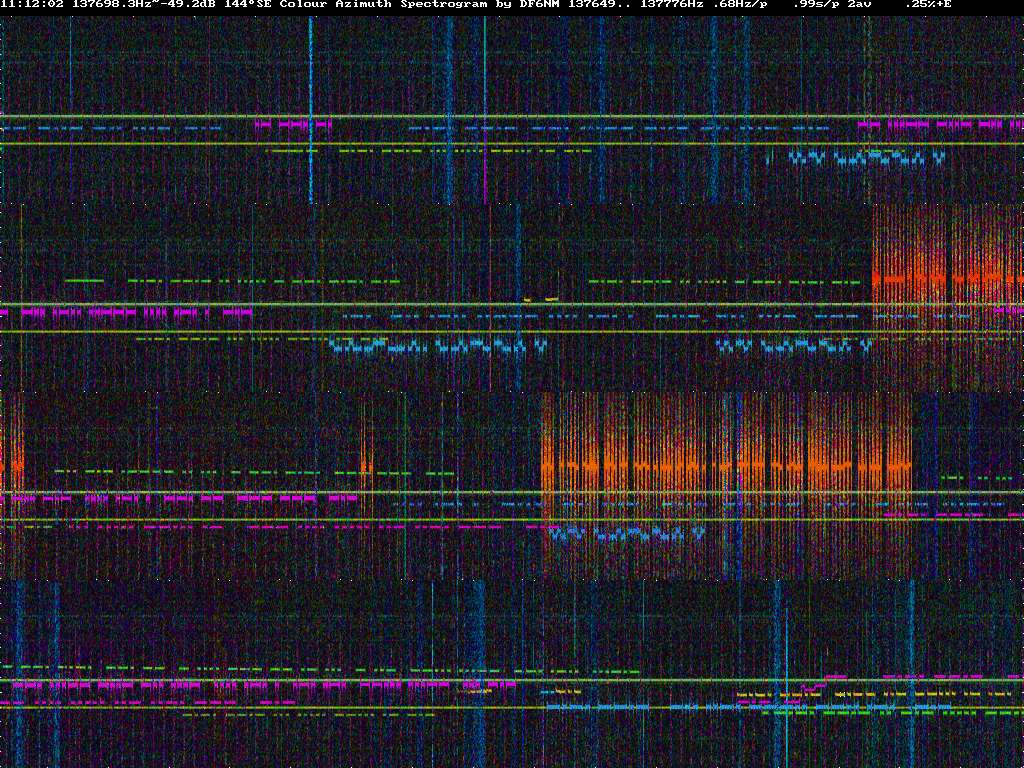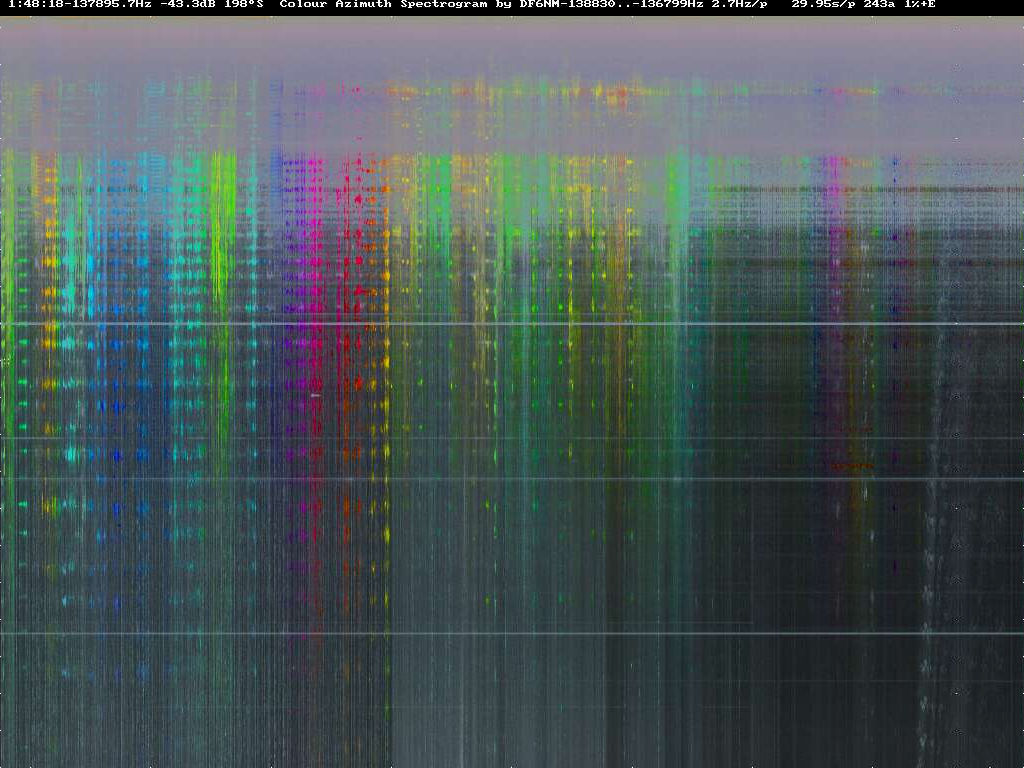












Now see some colour-spectrogram image examples:

The first image (Mar 25, 2002)
The blue noise band above 134 kHz is an intermodulation alias of DCF42's DGPS-data sideband. It is picked up by DCF49's antenna at the same site, modulated by the nonlinear power stage at 128.93 kHz and retransmitted. The pilot carrier, originally at 122.5 kHz, reappears at 135.36 kHz and carries DCF49's FSK bursts with doubled shift.
During the experiment, the loop pair on the balcony was rotated slowly around a vertical axis, demonstrating the azimuth-to-colour conversion for the first time. - As the second (loop) channel was only a direct conversion receiver then, Datatrak signals were folded in from below 134 kHz. Lacking their counterpart in the first channel, they appear in grey.

HELL QSO with DF0WD (April 28, 2002)
After my CQ in Chirped Hell mode near the image center (gray, overloading the RX), Wolf answered in SMT Hell, which looked quite pretty with a little more averaging. As you can see, after the second over both of us became a little impatient with the slow mode and decided to switch to PSK31.
The pink and green noise in the above image consists of impulses repeating at 33 Hz, twice the railway powerline frequency. As it slowly changes colour, I assume it originates in a voltage converter on a vehicle, moving along the railway line about 400 m from my QTH. Their overhead power lines are not shielded by a grounded top conductor.

QRN all around (May 10, 2002)
The shot above was taken around 16:00 local, with static crashes coming in from almost every direction. Three hours later, the scene had somewhat changed...


Several CW signals, (Sep 8, 2002)
including DN1VLF, DK8ND, DJ2EY and others. At the time, the FSK bursts from DBF39 (top) and DCF49's IMP (bottom) were synchroneous with a 60 ms delay between master and slave. Now they are controlled independently.

Night effect on DCF42 (Sep 25, 2002)
This image shows a very slow view of the DCF42 wideband DGPS data signal, with the 122.5 kHz carrier on the bottom. The spectrogram starts halfway in the first row at 23:00 local time and ends in the morning around 09:00; timer ticks indicate 10 minute intervals. The spectrogram was taken with two loops, with right hand versus left hand circular hybrid outputs on the two receivers.
The time- and frequency dependent variations in apparent angle of arrival are due to a superposition of the groundwave, which is generally dominant at 160 km, and a sky-wave which is influenced by ionospheric variations. Possible interpretations are either geometric off-angle reflections from a slightly tilted layer, or Faraday polarization rotations of horizontal field components, affecting the loops. After sunrise, the skywave is absorbed and the strip returns to a uniform blue colour, corresponding to the azimuth of the pure groundwave.

Datatrak (Oct 7, 2002)
This shows several stations belonging to three Datatrak chains near 145 kHz. On each frequency, pairs of bits come from different stations who transmit sequentially in time synchronism, for the purpose of radio-location of moving vehicles by delay measurements. - There is a second similar band below 133 kHz.

Donebach spurs (Nov 30, 2002)
Several times in the past, the transmissions of Deutschlandfunk at 153 kHz were accompanied by nasty spurious sidebands, about +-16 kHz from the carrier and only 60 dB below their radiated power of 500 kW. They originated from a parasitic oscillation in the controller of the 54 kHz switchmode modulator, and were frequency-modulated over several kHz with the AM modulation content. In quiet periods, the noise band narrowed to an unstable and drifting carrier about 200 Hz wide.- Luckily, one of the site engineers has found that the spurs could be suppressed by cooling a certain CD4011 on one of the printed circuit boards.

Jason mode from M0BMU (Jan 11, 2003)
Jason is a weak signal mode created by I2PHD and IK2CZL. Using one of 17 narrow spaced frequencies, it can transmit 4 bits with every 10 second dash. Can you read the message by hand?

Transatlantic beacon (Feb 9, 2003)
This is RU6LA's 60-second QRSS near 135922 Hz, a frequency used many times by Europeans to be received in North America.

Battery charger (Feb 14, 2003)
This funny and audible pattern made an amazing change to the ever-present SMPS noises with their ugly, drifting 100-Hz-bands. It probably comes from a switch-mode battery charging device, whose chopper frequency is pulled a bit while it periodically interrogates charging status. Like a lot of the local intererence, it is seen by the loops only.

QRSS and DFCW signals (March 9, 2003)
The above image of the top part of the LF amateur band was taken on a sunday morning and shows quite a bit of activity from G3XDV, DL2HRE, S57A, DF8ZR, I5TGC, DK1IS (50 km from me), OH5UFO, YU7AR and IK5ZPV. Background signals are DBF39 FSK-bursts every 10 s (purple vertical lines), the continuous carrier on 137689.6 (yellow) and a sample-rate alias of DBF39's carrier.

CFH Halifax (May 27, 2003)
The prominent feature in the center of this eight hour night-view is CFH, a Canadian Navy station transmitting on 137.0 kHz FSK. It was visible from about 23:30 to 4:30 UT, with typical propagational azimuth variations. On the bottom end, yellow sidebands of SXV from Greece can be seen, with a rather rapid fadeout around 2:30 UT, and returning to daytime levels around 06:00.
The cursor's four white dots are positioned around the DFCW signal of CT1DRP, in one of his many (and often successful) attempts to cross the Atlantic. Though the 0.1 Hz shift is not resolved here, Brian can be clearly identified by the duration of the letters in his callsign at 60 seconds per dash.
There is an equispaced triplet of continuous blue lines on 136200, 136680 and 137161 Hz which (like DCF42/49) seem to originate from the Frankfurt area. Interestingly, the fading patterns of these lines are quite similar, indicating a common origin from a single antenna. However the pattern is different from the one on 136547.5 Hz, which is a well known IM line transmitted by DCF49.
The "golden curtain" after 5:30 UT looks like a local switched mode power supply, drifting across the band. It occurs at variable times almost every morning.
The purple bands coming in from the top are Luxembourg-type ionospheric cross modulation sidebands, impressed on DBF39 mostly by Deutschlandfunk and the Voice of Russia on medium wave. The spectral maxima correspond to the presence of musical notes in the modulation contents.

Strong Luxembourg effect in the QRSS segment (Mar 15, 2003)
During many nights, Luxembourg cross modulation around DBF at 138.83 kHz is the strongest source of interference in the upper part of the LF amateur band. In this example, you can see OH5UFO drowning in the sidebands. So I was wondering if something could be done about it...


Luxembourg effect correlation experiment (Dec 27, 2002)
The frequency scale in this image is inverted, showing the lower sideband from 138.83 kHz zero beat. Only the part of Luxembourg heating correlated with 549 kHz produces strong colours, other modulation contents and the FSK sidebands are grey.
A delay between the direct mediumwave path and the ionospheric modulation would result in a frequency-dependent phase. In this measurement, delay was almost zero, as would be expected with both transmitters almost in line-of-sight from the receiver. However, the absolute phase changed several times over the hours, indicating variations in the height or depth of the nonlinear interaction zone.
This presentation was updated July 4, 2003. - Comments are welcome to 